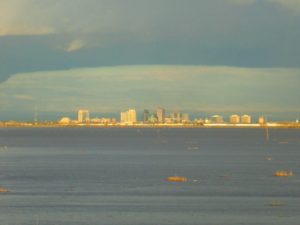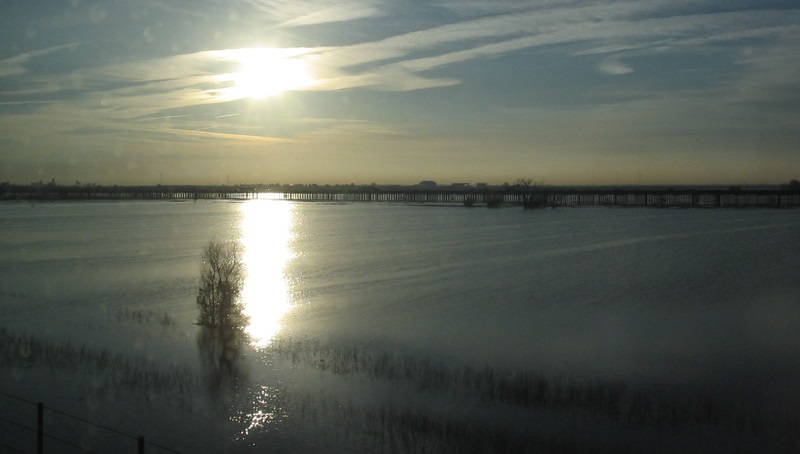The Yolo Bypass is one of two flood bypasses in California‘s Sacramento Valley located in Yolo and Solano Counties.
Sacramento experienced several severe floods prior to construction of the bypass. During wet years, the bypass can be full of water. Through a system of weirs, the bypass diverts floodwaters from the Sacramento River away from the state’s capital city of Sacramento and other nearby riverside communities.
The Yolo Bypass contains the Fremont Weir Wildlife Area, Sacramento Weir Wildlife Area and Yolo Bypass Wildlife Area. The Vic Fazio Yolo Wildlife Area is part of the Yolo Bypass Wildlife Area, and was the largest public/private restoration project west of the Florida Everglades. The entire bypass forms a valuable wetland habitat when flooded during the winter and spring rainy season. In the summer, areas of the bypass outside the wildlife areas are used for agriculture.
The Yolo Bypass provides habitat for over 280 terrestrial vertebrate species, changing throughout the seasons. The natural flooding provides an exceptionally good nursery habitat for native fish species, including the endangered Chinook salmon. Juvenile salmon have been found to grow substantially better in the Yolo Bypass than the adjacent Sacramento River. Other special-status wildlife residing in the Yolo Bypass includes giant garter snake, fairy shrimp, bald eagle, Swainson’s Hawk, and more.
On December 22, 2017, the California Department of Water Resources and federal Bureau of Reclamation took steps toward improving fish passage and restoring breeding habitat in the Yolo Bypass with the release of the draft environmental document for the proposed Yolo Bypass Salmonid Habitat Restoration and Fish Passage Project in Yolo and Sutter counties. The document is being made available for public review and comment.

Flooded Yolo Bypass in March 2006, looking east from Davis to Sacramento. Photo credit: Friedpez via Wikipedia.
The draft Environmental Impact Statement/Environmental Impact Report (EIS/EIR) identifies methods to improve adult fish passage and increase floodplain rearing habitat for juvenile salmonids in the Yolo Bypass.
The document analyzes the effects of taking no action and six alternatives that would put one or more gated notches in the Fremont Weir, at the northern end of the Yolo Bypass.
The goal of the project is to increase the volume of water entering the Yolo Bypass in an effort to pull more fish onto the bypass and create a larger floodplain area.
This would allow juvenile salmon to feed in a food-rich area for a longer time where they can rapidly grow to a large size, thus improving their chances of survival as they travel to the ocean. The project would also reduce migratory delays for adults returning to their spawning grounds.
The project increases the availability of floodplain fisheries rearing habitat for juvenile Sacramento River winter-run Chinook salmon, Central Valley spring-run Chinook salmon and Central Valley steelhead, per Reasonable and Prudent Alternative (RPA) action I.6.1 as described in the existing biological opinion from the National Marine Fisheries Service.
It also reduces fish passage migratory delays and loss of fish at Fremont Weir and other structures in the Yolo Bypass for salmon, steelhead and sturgeon, per RPA action I.7. Analysis under CEQA indicates the potential for significant impacts to water quality, fisheries, agricultural resources, air quality, and noise caused by the construction and/or operation of some of the alternatives under consideration.
Featured photo by Steven Gross (via Wikipedia) shows another view of the flooded Yolo Bypass in 2006.

